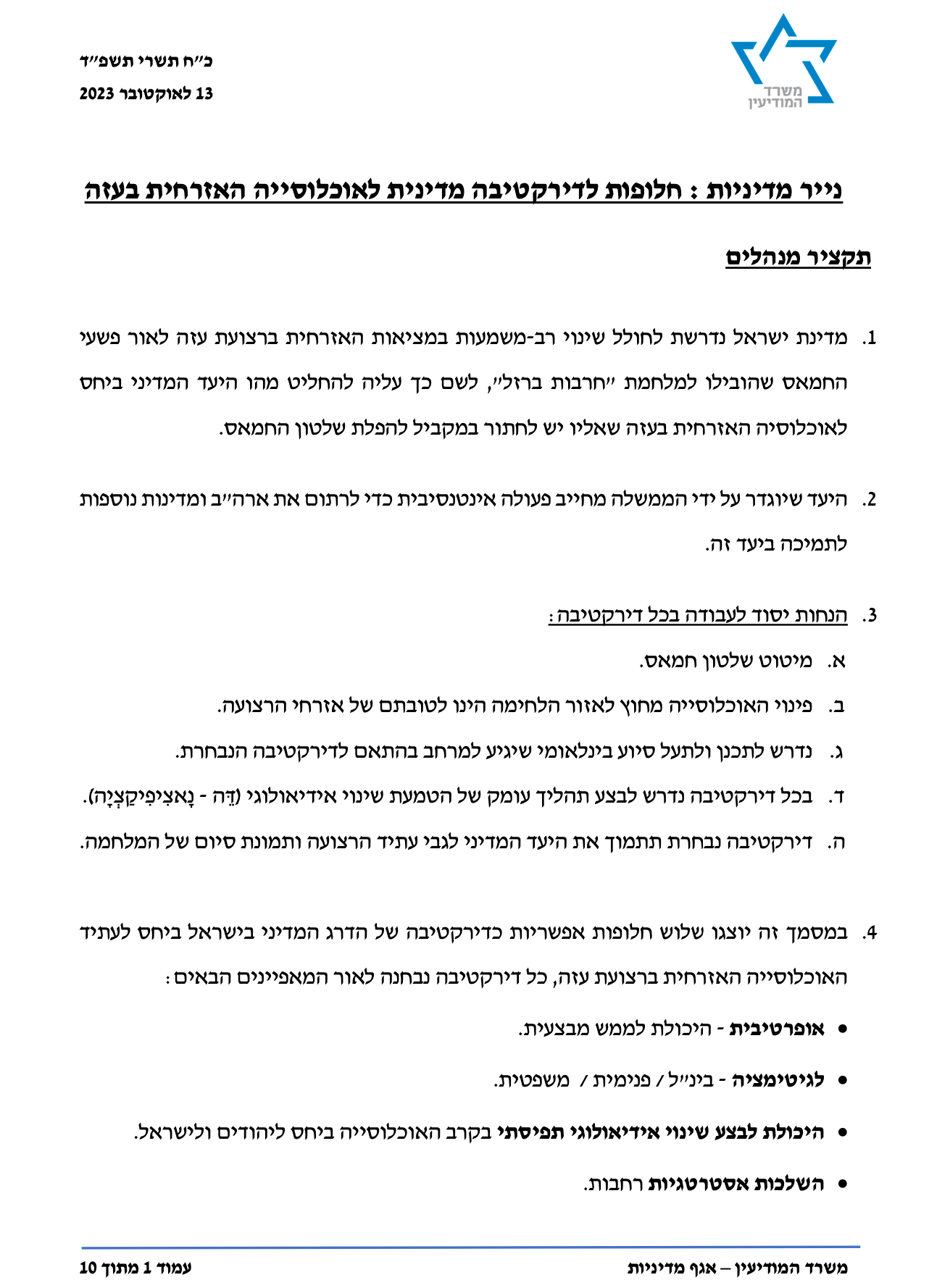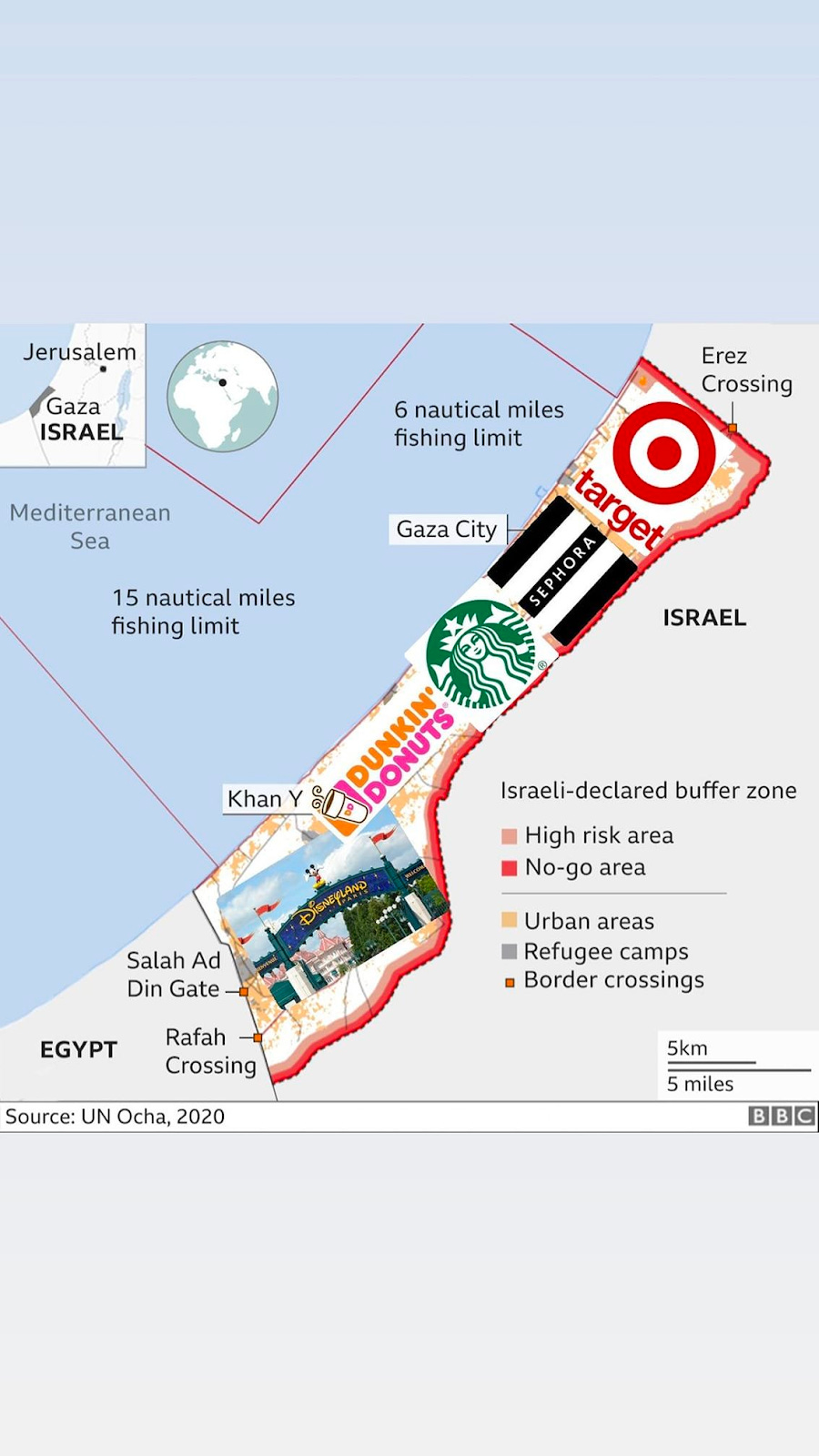“Option C” – Israeli Government Policy Paper Lays Out Plan for Ethnic Cleansing of Gaza
The paper calls for “intensive action to harness the US and other countries in support of this goal.”

Editor’s note: An Israeli citizen participated in writing this article, however, they have chosen to remain anonymous for their own safety.
Uncaptured News has received an internal Israeli government document that explicitly calls for the ethnic cleansing of the Gaza Strip.
Titled ‘Policy paper: Options for a political directive for the civilian population in Gaza’, the document was composed by the Israeli government Intelligence office and published on October 13, 2023, 6 days after the Hamas attack in southern Israel. The paper lays out three options for the subjugation of the Gaza Strip, including a scenario to carry out a full ethnic cleansing – “Option C”. Its author makes clear that this is the preferred option, noting that it “would yield positive and long-term strategic results for Israel, and is a feasible option.”
The following is the executive summary of the paper:
The State of Israel is required to bring about a significant change in the civilian reality in the Gaza Strip in light of the Hamas crimes that led to the "Iron Swords" war. To this end, it must decide what the political goal is in relation to the civilian population in Gaza that must be pursued in parallel to the overthrow of the Hamas regime.
The goal that will be defined by the government requires intensive action to harness the US and other countries in support of this goal.
Basic working assumptions in any directive:
Toppling of Hamas rule.
The evacuation of the population outside the combat zone is in the interest of the residents of the Gaza Strip.
It is required to plan and channel international aid that will reach the region in accordance with the selected directive.
In any directive it is required to carry out a deep process of assimilating an ideological change (de-Nazification).
A selected directive will support the political goal regarding the future of the Gaza Strip and an “end picture” of the war.
This document presents three possible options for a directive of the political level in Israel in relation to the future of the civilian population in the Gaza Strip, each directive was examined in light of the following characteristics:
Operative – the ability to realize operationally.
Legitimacy – international / internal / legal.
The ability to make an ideological and perceptual change among the population in relation to Jews and Israel.
Broad strategic implications.
The three options examined are:
Option A: The population remaining in Gaza and the importation of PA rule.
Option B: The population remaining in Gaza and the upbringing of local Arab rule.
Option C: Evacuation of the civilian population from Gaza to Sinai.
From an in-depth look at the options, the following insights can be obtained:
Option C – the option that would yield positive and long-term strategic results for Israel, and is a feasible option.
Options A and B suffer from significant deficiencies, mainly in terms of their strategic implications and long-term infeasibility. Both will not provide the necessary deterrent effect, will not allow a change of mindset, and may lead within a few years to the same problems and threats that the State of Israel faced from 2007 until today.
Option A is the option with the most risks, the division in the Palestinian population in the West Bank and Gaza is one of the main factors that make it difficult to establish a Palestinian state. Choosing this option means an unprecedented victory for the Palestinian national movement, a victory that will come at the cost of thousands of Israeli citizens and soldiers and does not guarantee Israel's security.
The emergence of this paper is strikingly similar to the infamous Plan Dalet, the fourth and most aggressive option conceived in the 1940s, which was put in action in the 1947-1948 ethnic cleansing of Palestine – known as the Nakba -– and the founding of the State of Israel.
The paper includes descriptions and analyses of all three options, along with their respective benefits and drawbacks, but primarily focuses on why Option C – a forced transfer of the population of Gaza Strip into the Egypt Sinai desert – is preferable.
Option C is described in more operational detail compared to the other options, along with explanations of why its perceived drawbacks, in particular the damage of Israel’s international legitimacy, will be disproven in the aftermath.
The paper admits that Option C “At first look, … seems to be complicated from international legitimacy perspective”, but then argues that it is actually better than the alternatives because it would not require the Israeli military to maintain a presence among the civilian population, and would therefore reduce the number number of civilian casualties, and therefore is actually the best option even from the perspective of international legitimacy.
Furthermore, the paper claims that “Massive migration from fighting zones (Syria, Afghanistan, Ukraine) and population movement is a natural and necessary result in light of the dangers of staying in the battlefield”. In essence, the claim is that transferring the Gaza population out of the strip can be “sold” to the international community as a natural migration of refugees fleeing out of war zones, rather than the deliberate ethnic cleansing operation that they propose.
While Option C is presented in terms of its advantages, Options A and B are described in terms of their disadvantages.
Option A – toppling Hamas and imposing Palestinian Authority (PA) rule in Gaza – is presented as a dangerous alternative because it would undermine Israel’s strategy of divide-and-conquer, and ultimately “does not guarantee Israel's security.”
“The division between the Palestinian population in the West Bank and Gaza is one of the main obstacles today to the establishment of a Palestinian state. It is impossible for the result of this attack to be an unprecedented victory for the Palestinian national movement and to pave the way for the establishment of a Palestinian state,” the paper explains.
This argument implicitly reveals that Israel’s de-facto policy is to oppose the establishment of a Palestinian state, even by the PA, which is funded by the European Union and the United States, and operates on Israel’s behalf.
It also reveals the historic role of Hamas, in Israel’s view, in dividing the Palestinian people and thwarting their ability to join forces in a united national struggle. This is precisely why Israel allowed Hamas to flourish in the 1980s, and why it covertly worked to retain its power as the ruling party of Gaza while actively enforcing PA rule in the West Bank.
Overall, the paper’s lack of operational detail, shallow reasoning and half-baked analysis, amounts to an attempt to justify the depopulation of the Gaza Strip’s 2.4 million residents, with two other nearly identical options listed only to convince readers of their impracticability.
Whichever option Israel adopts, its planners view unbridled U.S. support as key to achieving its plans for Gaza. The paper notes that “The goal that will be defined by the government requires intensive action to harness the US and other countries in support of this goal.”
‘A day will come when we will return’
The depopulation paper comes amid a widespread perception among Israelis, from top political figures to ordinary citizens, that the Hamas attack on October 7 provided Israel with a unique and rare opportunity to re-conquer Gaza, wipe out the Palestinian population and settle it with Israeli Jews.
The surprising failure of the massive and technology-advanced defense system controlling the Gaza fence to prevent the attack, followed by relentless carpet bombing of Gaza, and an extraordinary order of 1.1 million Palestinians living in the northern half of the Gaza strip to flee to the south within 24 hours, have raised the suspicion of an Israeli conspiracy to provoke an attack that would create the conditions that would enable Israel to realize its long-sought ambition to ethnically cleanse Gaza and annex it once and for all.
Indeed, on October 9, Prime Minister Netanyahu declared that Israel’s response to the Hamas attack “will change the Middle East.”
The fact that the policy paper that was generated by the intelligence ministry just six days after the shocking attack only reinforces this belief. If not intentionally provoked by Israel, the October 7 attack is undoubtedly perceived as a historic opportunity by many Israeli politicians and citizens alike.
Israeli governments have perceived the Gaza strip as within its natural borders ever since it was conquered in 1967. Soon after that war, the Israeli government discussed its terms and positions regarding the upcoming post-war negotiations, and concluded that “the Gaza Strip will be included in the State of Israel, according to the international border.”
Plans to expel Gaza’s population began at the same time. In the early years, the intentions were to compel Palestinians to leave by creating miserable conditions in Gaza, and providing incentives like money, transportation and professional education.
Clandestine military units executed plans to transfer Gaza’s population to Jordan, Persian Gulf countries, and countries in South America that agreed to accept them. These plans were so secretive that even Israeli military commanders that ruled the area were not made aware of them. Very few shared the secrets, and took most of the details with them to their graves.
Despite decades of efforts, Israel’s attempts to empty Gaza of the Palestinian people ultimately failed. It’s estimated that only a few tens of thousands left Gaza in the years following the 1967 occupation.
However, over the years, Israeli efforts to pressure Gaza’s population to flee became increasingly aggressive, violent and lethal. Israel launched repeated military assaults on Gaza, unprecedented in scale, beginning in 2008 with Operation Protective Edge. These continued up to the present day, with the intention of depopulating Gaza and taking over settlements.
In May, Orit Struck, Israel’s Minister of Settlements and member of the far-right Religious Zionism Party, made Israel’s long-term goals for Gaza clear. “We are in the process of a different national insight. I don't know how many years it will take. Unfortunately, a return to the Gaza Strip will also involve many sacrifices […] but there is no doubt that at the end of the day this is a part of the Land of Israel, and a day will come when we will return to it.”
The efforts to depopulate the Gaza Strip and transfer its population to Egypt began shortly after Hamas came to power after Israel’s 2005 “disengagement” and evacuation of Israeli settlements and military bases from the enclave. As early as 2007, Washington began to pressure Egypt to accept the resettlement of the Gaza population in the Sinai desert.
With massive demonstrations rocking western cities, shocking images of the human toll turning public opinion against Israel and favor of the Palestinian struggle, and a plucky armed resistance group awaiting Israeli military incursions, it appears that the government authors of the Israel’s vicious plans have miscalculated and Plan C is doomed to fail.




No comments:
Post a Comment